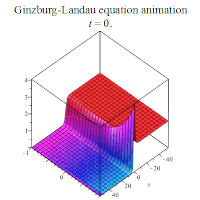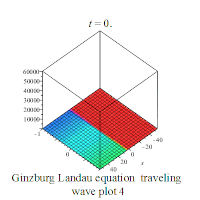金兹堡-朗道方程 ,或金兹堡-朗道理论 ,是由维塔利·金兹堡 和列夫·朗道 在1950年提出的一个描述超导 现象的理论[ 1] 唯象 的数学模型,从宏观的角度描述了第一类超导体 。1957年,苏联物理学家阿列克谢·阿布里科索夫 基于金兹堡-朗道理论提出了第二类超导体 的概念[ 2] 列夫·戈尔科夫 BCS理论 ,从微观角度严格证明了金兹堡-朗道理论是BCS理论的一种极限情况[ 3] 超流 理论的安东尼·莱格特 共同获得了2003年的诺贝尔物理学奖 。
金兹堡-朗道方程是由金兹堡和朗道在朗道的二级相变 理论的基础上提出的[ 4] 复 序参量 (complex order parameter)ψ(r ) 来表征。这个形似波函数 的序参量测量的是超导体在低于超导转变温度Tc 时的超导有序度("degree of superconducting order"),在BCS理论的框架中可以视为描述库柏对 质量中心位置的单粒子波函数[ 5] 自由能 密度
f
{\displaystyle f}
f
=
f
n
0
+
α
|
ψ
|
2
+
β
2
|
ψ
|
4
+
1
2
m
∗
|
(
ℏ
i
∇
−
e
∗
c
A
)
ψ
|
2
+
H
2
8
π
{\displaystyle f=f_{n0}+\alpha |\psi |^{2}+{\frac {\beta }{2}}|\psi |^{4}+{\frac {1}{2m^{*}}}\left|\left({\frac {\hbar }{i}}\nabla -{\frac {e^{*}}{c}}\mathbf {A} \right)\psi \right|^{2}+{\frac {H^{2}}{8\pi }}}
[ 6] 若
ψ
=
0
{\displaystyle \psi =0}
f
n
0
+
h
2
8
π
{\displaystyle f_{n0}+{\frac {h^{2}}{8\pi }}}
m
∗
{\displaystyle m^{*}}
有效质量 ,
e
∗
{\displaystyle e^{*}}
电荷 ,A 是磁矢势 ,
H
{\displaystyle H}
磁场强度 。在后续的实验中,人们发现
e
∗
≈
2
e
{\displaystyle e^{*}\approx 2{\mathit {e}}}
e
{\displaystyle {\mathit {e}}}
基本电荷 )。
当自由能取极小值时可得金兹堡-朗道方程 :
α
ψ
+
β
|
ψ
|
2
ψ
+
1
2
m
∗
(
ℏ
i
∇
−
e
∗
c
A
)
2
ψ
=
0
{\displaystyle \alpha \psi +\beta |\psi |^{2}\psi +{\frac {1}{2m^{*}}}\left({\frac {\hbar }{i}}\nabla -{\frac {e^{*}}{c}}\mathbf {A} \right)^{2}\psi =0}
由
J
=
c
4
π
∇
×
H
{\displaystyle \mathbf {J} ={\frac {c}{4\pi }}{\boldsymbol {\nabla }}\times \mathbf {H} }
电流密度
J
=
e
∗
m
∗
|
ψ
|
2
(
ℏ
∇
φ
−
e
∗
c
A
)
{\displaystyle \mathbf {J} ={\frac {e^{*}}{m^{*}}}\left|\psi \right|^{2}\left(\hbar \nabla \varphi -{\frac {e^{*}}{c}}\mathbf {A} \right)}
[ 6]
如果不考虑金兹堡-朗道方程中的磁场与梯度项,方程可化为:
f
s
−
f
n
=
α
|
ψ
|
2
+
1
2
β
|
ψ
|
4
{\displaystyle f_{s}-f_{n}=\alpha |\psi |^{2}+{\frac {1}{2}}\beta |\psi |^{4}}
[ 6] 由于
β
>
0
{\displaystyle \beta >0}
α
>
0
{\displaystyle \alpha >0}
|
ψ
|
2
=
0
{\displaystyle |\psi |^{2}=0}
α
<
0
{\displaystyle \alpha <0}
|
ψ
|
2
=
−
α
β
=
|
ψ
∞
|
2
{\displaystyle |\psi |^{2}=-{\frac {\alpha }{\beta }}=|\psi _{\infty }|^{2}}
|
ψ
∞
|
2
{\displaystyle |\psi _{\infty }|^{2}}
ψ
{\displaystyle \psi }
[ 6]
若已知
e
∗
=
2
e
{\displaystyle e^{*}=2{\mathit {e}}}
m
∗
=
2
m
{\displaystyle m^{*}=2m}
|
ψ
|
2
∝
1
−
t
4
≈
4
(
1
−
t
)
{\displaystyle |\psi |^{2}\propto 1-t^{4}\approx 4(1-t)}
α
∝
1
−
t
2
1
+
t
2
≈
(
1
−
t
)
{\displaystyle \alpha \propto {\frac {1-t^{2}}{1+t^{2}}}\approx (1-t)}
β
∝
1
(
1
+
t
2
)
2
≈
c
o
n
s
t
{\displaystyle \beta \propto {\frac {1}{(1+t^{2})^{2}}}\approx const}
其中
t
=
T
/
T
c
{\displaystyle t=T/T_{c}}
[ 6]
金兹堡-朗道方程预测了超导体中两个新的特征长度。
第一个叫做超导相干长度 ξ 。对于T > Tc (一般相),相干长度由以下方程给出:
ξ
=
ℏ
2
2
m
|
α
|
.
{\displaystyle \xi ={\sqrt {\frac {\hbar ^{2}}{2m|\alpha |}}}.}
对于 T < Tc (超导相),相干长度由以下方程给出:
ξ
=
ℏ
2
4
m
|
α
|
.
{\displaystyle \xi ={\sqrt {\frac {\hbar ^{2}}{4m|\alpha |}}}.}
第二个叫做穿透深度 λ 。这个概念最初是由伦敦兄弟在他们的伦敦理论 中提出的。如果使用金兹堡-朗道模型中的参数来表示,穿透深度可以写作:
λ
=
m
4
μ
0
e
2
ψ
0
2
,
{\displaystyle \lambda ={\sqrt {\frac {m}{4\mu _{0}e^{2}\psi _{0}^{2}}}},}
其中ψ0 表示在没有电磁场的条件下序参量的平衡值。外加磁场在超导体中的指数衰减可以通过穿透深度来定义。通过计算超导电子密度恢复到其平衡值ψ0 时产生的微小扰动,我们可以确定这个指数衰减。磁场的指数衰减与高能物理中的希格斯机制 是等价的。
朗道还定义了一个参数κ 。κ =
λ
{\displaystyle \lambda }
ξ
{\displaystyle \xi }
金兹堡-朗道参数 。朗道提出,第一类超导体 应满足 0<κ <1/
2
{\displaystyle {\sqrt {2}}}
第二类超导体 应满足κ >1/
2
{\displaystyle {\sqrt {2}}}
金兹堡-朗道方程可化为以下形式的非线性偏微分方程 :
∂
u
∂
t
−
a
∂
2
u
∂
x
2
−
b
u
+
c
|
u
|
2
u
=
0
{\displaystyle {\frac {\partial u}{\partial t}}-a{\frac {\partial ^{2}u}{\partial x^{2}}}-bu+c|u|^{2}u=0}
[ 7]
其中
u
(
x
,
t
)
{\displaystyle u(x,t)}
s
o
l
[
1
]
:=
u
=
−
(
1
/
2
)
∗
b
/
(
c
∗
b
)
+
(
1
/
2
)
∗
(
c
∗
b
)
∗
t
a
n
h
(
C
1
+
(
1
/
4
)
∗
(
2
)
∗
(
a
∗
b
)
∗
x
/
a
−
(
3
/
4
)
∗
b
∗
t
)
/
c
{\displaystyle sol[1]:=u=-(1/2)*b/{\sqrt {(}}c*b)+(1/2)*{\sqrt {(}}c*b)*tanh(_{C}1+(1/4)*{\sqrt {(}}2)*{\sqrt {(}}a*b)*x/a-(3/4)*b*t)/c}
s
o
l
[
2
]
:=
u
=
−
(
1
/
2
)
∗
b
/
(
c
∗
b
)
+
(
1
/
2
)
∗
(
c
∗
b
)
∗
c
o
t
h
(
C
1
+
(
1
/
4
)
∗
(
2
)
∗
(
a
∗
b
)
∗
x
/
a
−
(
3
/
4
)
∗
b
∗
t
)
/
c
{\displaystyle sol[2]:=u=-(1/2)*b/{\sqrt {(}}c*b)+(1/2)*{\sqrt {(}}c*b)*coth(_{C}1+(1/4)*{\sqrt {(}}2)*{\sqrt {(}}a*b)*x/a-(3/4)*b*t)/c}
s
o
l
[
3
]
:=
u
=
−
(
1
/
2
∗
I
)
∗
b
/
(
−
c
∗
b
)
−
(
1
/
2
)
∗
(
−
c
∗
b
)
∗
t
a
n
(
C
1
+
(
1
/
4
)
∗
(
−
2
∗
a
∗
b
)
∗
x
/
a
−
(
3
/
4
∗
I
)
∗
b
∗
t
)
/
c
{\displaystyle sol[3]:=u=-(1/2*I)*b/{\sqrt {(}}-c*b)-(1/2)*{\sqrt {(}}-c*b)*tan(_{C}1+(1/4)*{\sqrt {(}}-2*a*b)*x/a-(3/4*I)*b*t)/c}
s
o
l
[
4
]
:=
u
=
−
(
1
/
2
)
∗
b
/
(
c
∗
b
)
+
(
1
/
2
)
∗
(
c
∗
b
)
∗
t
a
n
h
(
C
1
+
(
1
/
4
)
∗
(
2
)
∗
(
a
∗
b
)
∗
x
/
a
−
(
3
/
4
)
∗
b
∗
t
)
/
c
{\displaystyle sol[4]:=u=-(1/2)*b/{\sqrt {(}}c*b)+(1/2)*{\sqrt {(}}c*b)*tanh(_{C}1+(1/4)*{\sqrt {(}}2)*{\sqrt {(}}a*b)*x/a-(3/4)*b*t)/c}
s
o
l
[
5
]
:=
−
(
3
)
∗
e
x
p
(
−
1
−
(
1
/
4
)
∗
(
3
)
∗
x
+
(
9
/
4
)
∗
t
)
(
e
x
p
(
1
+
(
1
/
4
)
∗
(
3
)
∗
x
−
(
9
/
4
)
∗
t
)
+
e
x
p
(
−
1
−
(
1
/
4
)
∗
(
3
)
∗
x
+
(
9
/
4
)
∗
t
)
)
{\displaystyle sol[5]:={\frac {-{\sqrt {(}}3)*exp(-1-(1/4)*{\sqrt {(}}3)*x+(9/4)*t)}{(exp(1+(1/4)*{\sqrt {(}}3)*x-(9/4)*t)+exp(-1-(1/4)*{\sqrt {(}}3)*x+(9/4)*t))}}}
谷超豪 《孤立子 理论中的达布变换 及其几何应用》 上海科学技术出版社
阎振亚著 《复杂非线性波的构造性理论及其应用》 科学出版社 2007年
李志斌编著 《非线性数学物理方程的行波解》 科学出版社
王东明著 《消去法及其应用》 科学出版社 2002
何青 王丽芬编著 《Maple 教程》 科学出版社 2010 ISBN 9787030177445
Graham W. Griffiths William E.Shiesser Traveling Wave Analysis of Partial Differential p135 Equations Academy Press
Richard H. Enns George C. McCGuire, Nonlinear Physics Birkhauser,1997
Inna Shingareva, Carlos Lizárraga-Celaya,Solving Nonlinear Partial Differential Equations with Maple Springer.
Eryk Infeld and George Rowlands,Nonlinear Waves,Solitons and Chaos,Cambridge 2000
Saber Elaydi,An Introduction to Difference Equationns, Springer 2000
Dongming Wang, Elimination Practice,Imperial College Press 2004
David Betounes, Partial Differential Equations for Computational Science: With Maple and Vector Analysis Springer, 1998 ISBN 9780387983004
George Articolo Partial Differential Equations & Boundary Value Problems with Maple V Academic Press 1998 ISBN 9780120644759


































![{\displaystyle sol[1]:=u=-(1/2)*b/{\sqrt {(}}c*b)+(1/2)*{\sqrt {(}}c*b)*tanh(_{C}1+(1/4)*{\sqrt {(}}2)*{\sqrt {(}}a*b)*x/a-(3/4)*b*t)/c}](https://wikimedia.org/api/rest_v1/media/math/render/svg/1e21bcdaf6e973982620d3087aaeb015c1ac6a20)
![{\displaystyle sol[2]:=u=-(1/2)*b/{\sqrt {(}}c*b)+(1/2)*{\sqrt {(}}c*b)*coth(_{C}1+(1/4)*{\sqrt {(}}2)*{\sqrt {(}}a*b)*x/a-(3/4)*b*t)/c}](https://wikimedia.org/api/rest_v1/media/math/render/svg/f210c9da3a403f1f9bb3f97e23dd4b2930a15f24)
![{\displaystyle sol[3]:=u=-(1/2*I)*b/{\sqrt {(}}-c*b)-(1/2)*{\sqrt {(}}-c*b)*tan(_{C}1+(1/4)*{\sqrt {(}}-2*a*b)*x/a-(3/4*I)*b*t)/c}](https://wikimedia.org/api/rest_v1/media/math/render/svg/51a6eb698f597c055af929e1fe67bf8cd128d603)
![{\displaystyle sol[4]:=u=-(1/2)*b/{\sqrt {(}}c*b)+(1/2)*{\sqrt {(}}c*b)*tanh(_{C}1+(1/4)*{\sqrt {(}}2)*{\sqrt {(}}a*b)*x/a-(3/4)*b*t)/c}](https://wikimedia.org/api/rest_v1/media/math/render/svg/a33c237c87e5ce078f112c65a53dc2d9f9eab641)
![{\displaystyle sol[5]:={\frac {-{\sqrt {(}}3)*exp(-1-(1/4)*{\sqrt {(}}3)*x+(9/4)*t)}{(exp(1+(1/4)*{\sqrt {(}}3)*x-(9/4)*t)+exp(-1-(1/4)*{\sqrt {(}}3)*x+(9/4)*t))}}}](https://wikimedia.org/api/rest_v1/media/math/render/svg/6440d663a4e57de7308b7ce9010c5dd8c8ec64f5)









